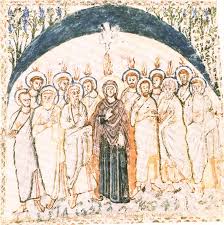My article “On the Foundation Period of the Maronite Tradition” has been published in Religions 2024 15(5), 596. It is available at mdpi.com/journal/religions. It is part of a special edition: Patristics, Essays from Australia, which was edited by Professor Garry Trompf, one of the world’s leading students of religion.
There is an introduction, followed by the following sections: Maroun and his legacy; The Ancient Ethos behind Maronite Expressions of the Christian Faith; The Monastery of St Maroun and its Vicissitudes; The Monothelite Controversy in the Seventh Century; Yohanon Maroun as Antiochene Patriarch; and In Retrospect.
I manage to cover the basics of early Maronite history and also provide an introduction to the spirituality of typology (seeing the pattern of heaven on earth).
The introduction speaks in a general way of what the Maronite Church is, then of the origins of the Church in Antioch through to Saints Ignatius and Theophiulus of Antioch, although the treatment of them cannot be lengthy. I also say something about types and symbols in the ancient Church.
Section 2, on St Maroun, speaks about monasticism, and sets out the latest research, which shows that the origins of monasticism were wider and broader than previously thought. In particular, it is not the case that monasticism was invented in Egypt, although its form and popularity did develop in a unique way there. There was also a native form of monasticism which was closely related to the teaching of Christ.
Section 2.1 sets out the life of St Maroun by Theodoret, with my own translation, and some notes about what it tells us of the great saint. I show that, contrary to some modern ideas, the only evidence about the date of his death is that he must have passed to his eternal reward by the year 423. Further, and this is new, by looking at the evidence for the spread of monasticism in Syria, for which Theodoret tells us he was responsible, then St Maroun could quite possible have been 100 years or more at the time of his death. Section 2.2. shows how his life follows the same pattern as that of St Anthony of Egypt, both being “great founder-figures.” Section 2.3 mentions St John Chrysostom’s letter to St Maroun.
In section 3 I speak, briefly, about the paucity of liturgical and other spiritual material from the early Maronite Church. But we do know that much was taken from Saints Ephrem and Jacob of Serug, so I have two pages about them and their contribution to the Syriac religious ethos. It is a funny thing, but useful for us, that while we have no Maronite liturgical material from their day and age, yet we have later documents which clearly show their influence. Despite the limitations of space, I was able to fit in a passage from St Jacob’s homily On the Friday of the Passion (Good/Great Friday) saying how we should learn to think about the meaning of feasts, because then our worship starts to come alive with understanding. In other words, knowledge can be a useful way of awakening the spirit within.
The monastery of St Maroun is dealt with in the fourth section. I briefly refer to all the available evidence, and conclude that the monastery was most likely near Homs in modern day Syria, which is not too far from the north Lebanese border. I visited the church there before the bombing broke out. I really delighted to be among those good simple people in their ancient home. It is also a beautiful part of the world. In this section I also manage to show from an ancient text by Procopius that the monastery was well known and important, was the subject of imperial care, and must have been in the area I have stated.
The massacre of 517 is in section 4.1, with a study of the Maronites as defenders of Chalcedonian orthodoxy in the sixth century. This covers the letters to and from the monks, which are well known. Then, in 4.2, I have the fascinating but little known “Maronite Chronicle.”
Controversy is king in chapter 5, the Monothelite discord which broke out in the empire, and even crossed into Rome. I go very radical and challenge the idea that Monothelitism must be a heresy as opposed to an error, and even more fundamentally, that there is a clear answer to the controversy which anyone should be able to follow. It is a fascinating topic, and one which, I think, is finally receiving a welcome reinterpretation.
Chapter 6 is, if anything, even more important, because it is, so far as I know, the first serious English language consideration of the question whether the Exposition of the Faith attributed to Saint Yohanon Maroun (St John Maroun) is indeed by him. I side with the late Fr Michel Breydy in arguing that the sparse evidence points to his being the author. If that is so, then we have important ancient evidence for the early Maronite Church and its mindset which, due to scepticism about the authorship of this document had been overlooked.
I close the article by noting the ascetic character of the Maronite tradition, and how we came to produce a unique liturgical current with a deep spirituality: practical and down to earth, while looking to heaven. It is quite a story, and I am humbly gratified to think that I have played a small role in getting it better known in the English-speaking world, and not just by rehashing what everyone else has said for three hundred years.
Errata: p. 6, half-way down urta should be Surta; p.15 half-way down delete <YES??; p.19, seven lines down, “if the Corinthian” should be “the Corinthian.”
